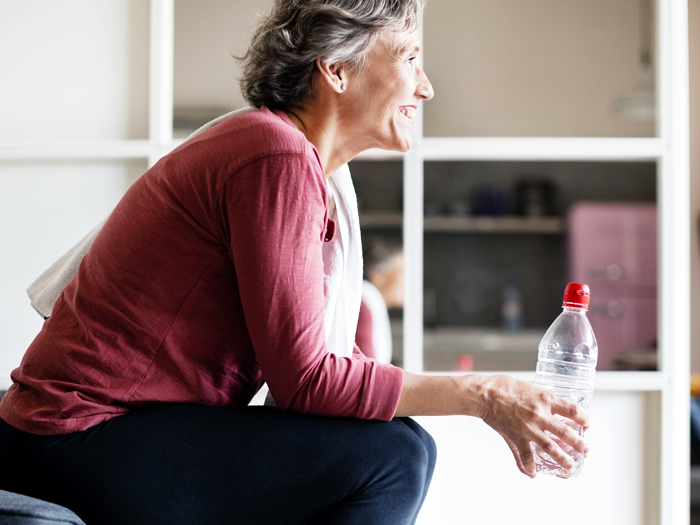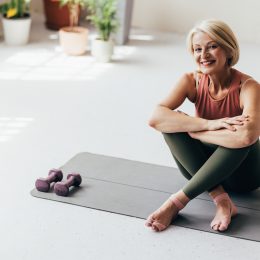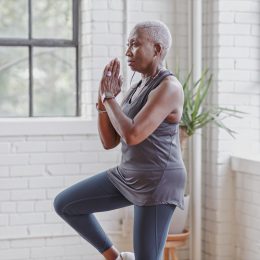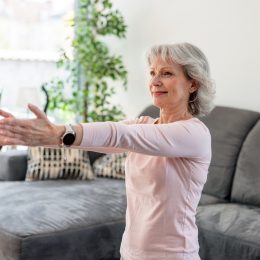9 Best Exercises and Workouts for Seniors
Stay strong, be safe, and maintain your independence by integrating these top fitness options into your training plan.

No matter your age, the best exercise for you is the one you enjoy the most. After all, if you don’t like your workout, how long are you going to stick with it?
Still, when sampling any of the countless forms of exercise out there, it’s important to keep in mind exactly what you want and need to get out of your workout. And that’s bound to change throughout the years, says Barbara Bergin, M.D., an orthopedic surgeon in Austin, Texas. She explains that, for older adults, the top priority must be maintaining your quality of life outside the gym.
To do that, focus on workouts designed to help you build strength, stay mobile, and improve balance. Also key is considering the requirements of any given fitness option. Are your bones strong enough for high-impact exercises such as running and jumping? Is your balance where it needs to be for fall-free bike rides? How much time to do you realistically have to spend at the gym?
Below, experts share the best exercises for older adults. As always, it’s smart to check with your doctor before beginning a new fitness program, especially if you have a chronic condition, balance issues, or injuries. The good news: Assuming your doctor hasn’t said a type of exercise is off-limits, choose whatever you like—they’re all terrific.
1. Swimming
There’s a reason swimming is called the world’s perfect exercise. Whether you’re performing the breaststroke, taking a water aerobics class, or playing Marco Polo with the grandkids, getting in the pool is a great way to increase your cardiovascular fitness while also strengthening your muscles, says Victoria Shin, M.D., a cardiologist at Torrance Memorial Medical Center in California.
It does all this while putting minimal stress on your bones and joints, which is a major plus for men and women who have arthritis or osteoporosis. As if that isn’t enough reason to jump in, a 2012 study in the Journal of Aging Research suggests that swimming can help older adults keep their minds as sharp as their bodies.
Not a swimmer? You can still benefit from water aerobics classes that stay in the shallow end of the pool, such as SilverSneakers Splash. And if you’re a confident swimmer, these 10 tips will help you get the most out of your swimming workout.
Ready for a pool workout? Find participating SilverSneakers fitness locations here. Tip: Use the “Filter” tool and click “amenities” to narrow your search to locations with pools.
2. Yoga
With a holistic approach to fitness, yoga helps build muscle strength, aerobic fitness, core stability, and total-body mobility—all of which are important for older adults, says David Kruse, M.D., a sports medicine specialist at the Hoag Orthopedic Institute in Orange, California.
And while yoga is low-impact and gentle on your body’s joints, it’s still weight-bearing, meaning that you have to support your body’s weight with every posture. That’s vital to strengthening not just your muscles, but also your bones.
If you are new to yoga, look for an introductory class that will teach you the basics. SilverSneakers Yoga is made for older adults and offers a chair so you can do poses seated or standing. Restorative, hatha, and Iyengar classes are also great options. Talk to your class instructor about any physical limitations before getting started.
3. Pilates
Like yoga, Pilates is known for being a low-impact strength program, but its focus on core stability makes it especially great for older adults, Dr. Shin says. One analysis in the European Review of Aging and Physical Activity concluded that Pilates participation improves balance in older adults.
Most gyms offer Pilates classes designed for first-timers, which is especially important for those interested in classes that rely on the “reformer,” an exercise machine that uses springs, bars, and straps for resistance. You can also give it a try with this at-home Pilates workout for a stronger core.
Try a SilverSneakers Yoga Pilates Fusion class! Build flexibility and endurance in this fun mind-body workout that combines the best of yoga, Pilates, and barre exercises. It’s offered both in-person and online. Check your eligibility here. Find participating SilverSneakers fitness locations here. View the current SilverSneakers LIVE schedule and RSVP here.
4. Bodyweight Training
One out of every three older adults experiences severe muscle loss, according to an analysis in Age and Ageing. Meanwhile, when it comes to fighting age-related abdominal fat—a marker for overall health—Harvard research shows that strength training is more time-efficient than cardiovascular exercise.
Fortunately, you don’t have to bench press a ton of weight to keep your muscles healthy and prevent fat gain over the years, Dr. Shin says. In fact, she notes, for most older adults, it’s far safer to start small. Simple bodyweight exercises such as chair squats, single-leg stands, wall pushups, and stair climbing will do a great job at keeping your body strong and ready to tackle everyday activities.
Here’s everything you need to know about strength training. Ready to try? Start with the sit-to-stand, which is a modified version of a squat that uses a chair.
5. Resistance Band Workouts
Your gym undoubtedly has an array of resistance bands ready for use, but these inexpensive and beginner-friendly exercise tools are perfect for at-home workouts as well, Dr. Shin says.
In addition, bands can help you challenge your muscles in ways you might not be able to with equipment-free training. For instance, when it comes to strengthening your back and improving your posture, rows and other pulling motions are vital—but hard to do if you don’t have any exercise equipment on hand.
Get started with our beginner’s guide to resistance bands.
6. Walking
Even if you can’t find the time to perform a structured workout, you likely have time to put one foot in front of the other to get where you need to go, Dr. Shin says. She recommends most people take 10,000 steps per day, even on days they don’t “work out.” Research in PLOS One found that people who increased their activity levels to 10,000 steps per day were 46 percent less likely to die in the following 10 years compared to those who stayed sedentary.
For some older adults or people with a chronic condition, 10,000 may not be the right exact number. But the fact remains: Walking is a great, free workout that can have a big impact on your health.
Check out the video below for easy ways to mix up your walking workout.
Subscribe to our newsletter
It's quick and easy. You could be one of the 13 million people who are eligible.
Already a member? Click to discover our 15,000+ participating locations.
Follow Us
7. Cycling
Another low-impact form of exercise, cycling is ideal for those who want to increase their leg strength, but can’t run or engage in other high-impact sports due to osteoporosis or joint issues, Dr. Shin says. A 2017 analysis in the European Review of Aging and Physical Activity found that cycling also helps improve cardiovascular health, metabolic health, and cognitive performance in adults older than 70.
If you have cycling trails near your home, consider scheduling regular bike rides with family or friends. Indoor cycling is another great option for those without access to trails or when weather conditions aren’t ideal. Plus, with a stationary bike, you don’t have to worry about falls or needing to wear a helmet.
8. Strength and Aerobic Classes
If you attend SilverSneakers classes, you already know that group exercise isn’t just a fantastic way to break a sweat. You’ll also have tons of fun and make new friends along the way, both of which are hugely important when it comes to making exercise a habit. In fact, 2017 research in BMC Public Health notes that the social aspect of group exercise increases activity levels in older adults over the long term.
There is no end to the list of group exercises out there, from SilverSneakers Classic to Zumba to boot camp. If you’re nervous about jumping into a new group, ask a friend to sign up with you — or try a SilverSneakers LIVE online class at home.
9. Personal Training
If you’re looking for more attention and instruction than group classes provide, working with a personal trainer is a great path to fitness and fun. Many offer one-on-one and small-group sessions, the latter in which you and one to three of your friends perform the same workout with the trainer. Make it easier on your wallet by using one-on-one sessions to help you get started with a program you can continue on your own or going the small-group route.
No matter which option you choose, the trainer will help you master proper form and build a solid base of exercise knowledge that you can carry with you for years to come. In addition, your workouts will likely blend different types of exercise.
When choosing a trainer, look for someone certified through a governing body like the American College of Sports Medicine, the American Council on Exercise, the National Academy of Sports Medicine, or the National Strength and Conditioning Association. Bonus points if they have a history of training older adults.
Check Your SilverSneakers Eligibility Instantly
SilverSneakers members can go to thousands of gyms and fitness locations across the nation, plus take SilverSneakers LIVE online classes that are designed for seniors of all levels. If you have a Medicare plan, it may include SilverSneakers—at no additional cost. Check your eligibility instantly here.
Not eligible for SilverSneakers? You can still get 200+ free SilverSneakers On-Demand videos and stay in touch with us by creating your online account.





